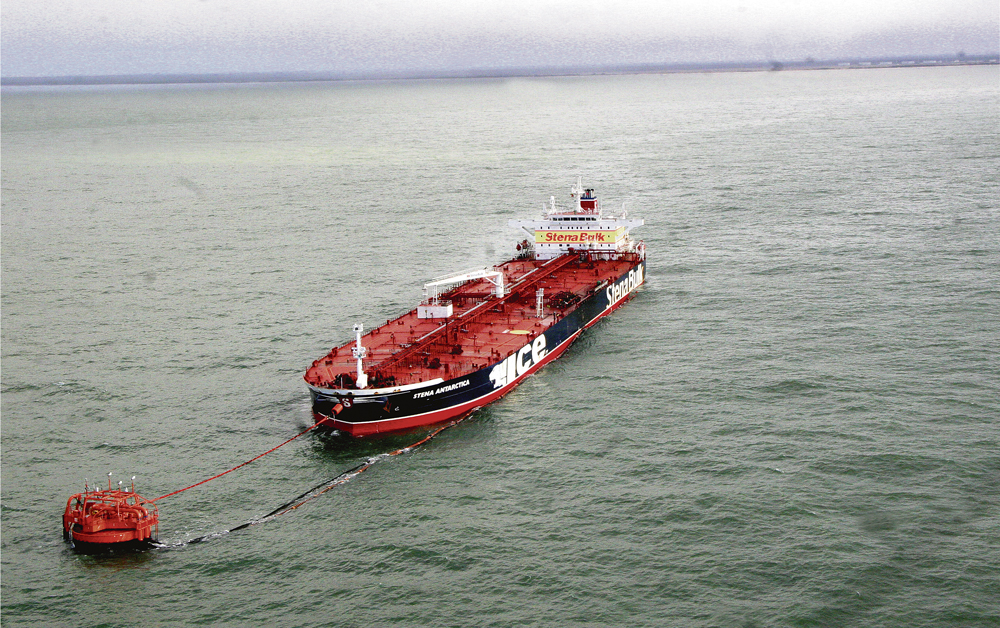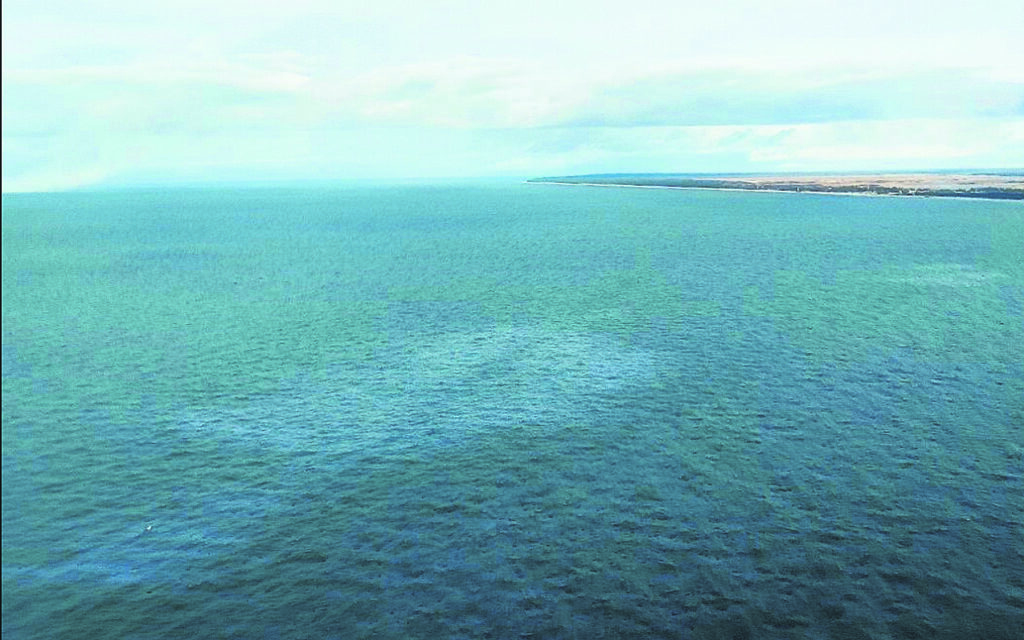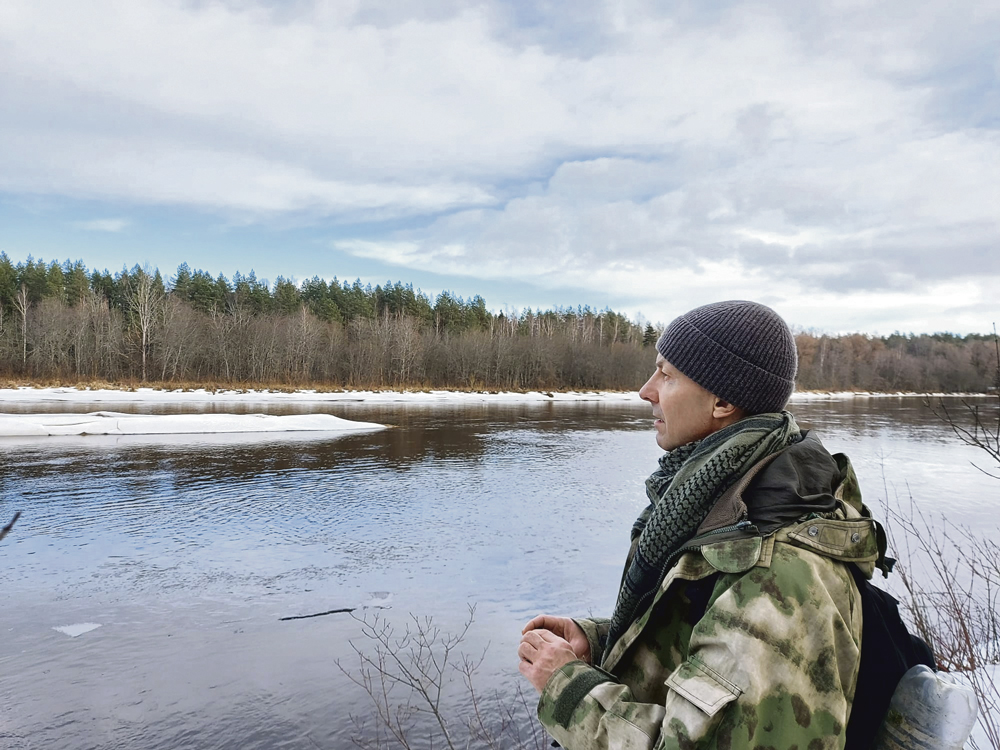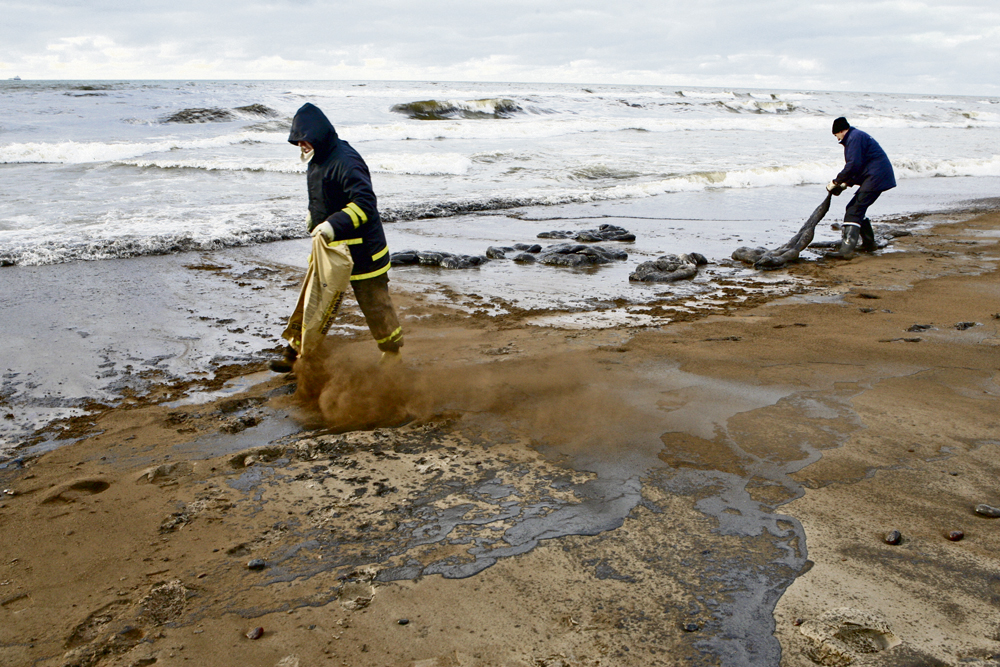Raivis Šveicars, “Latvijas Avīze”, Gabriele Novickaite, 15min.lt
“Būtingė Oil Terminal will be the cleanest and most technically advanced terminal on the Baltic Sea coast,” said Vladislavs Gedvils, the General Director of Būtingė Oil, almost 17 years ago. Just six months after the first oil tanker docked at the terminal, the first oil spill of almost three and a half tonnes also occurred. This was followed by six more oil spills. The last one was in February this year. What to do with the Būtingė Oil Terminal of Orlen Lietuva, which handles around eight million tonnes of oil a year? At what point do economic benefits become more important than environmental cleanliness? And at what point does energy security become more important than both? Should we follow suggestion of Felikss Klagišs to close the Būtingė terminal?
Statistical exercises before the trial
It is not yet known how much oil was spilled in February this year. Polish energy company Orlen, which owns the Būtingė terminal, says 300 litres leaked, while the Lithuanian Environmental Protection Department (LEPD) estimates the volume could be 1.8 tonnes. The Department points out that satellite images show that the contamination has spread over nine kilometres in length and is two kilometres wide, suggesting that the leak was much larger. “The company said 300 litres, but we see much more. An investigation is underway to determine the quantity. Some of the pollutants have reached Latvia. The figures do not add up,” the department told the BNS news agency more than a month ago.
LEPD told “Latvijas Avīze” that the amount of oil that had reached the sea could be even more than 1.8 tonnes, as some of the oil may have settled on the seabed and evaporated. The investigation is still ongoing. As the Būtingė Oil Terminal is included in a list of hazardous sites, LEPD, together with other environmental and safety authorities, inspects it every year. The case of last non-compliance with the law was in 2021, when Orlen paid 151 529 euros in fines to the Lithuanian Environmental Service.
It is suspicious that the data sent by LEPD and Orlen itself on the 2020 oil spill differ. Orlen says it leaked only 0.48 tonnes of oil in December 2020. However, LEPD points out that a more objective figure would be much higher – 0.95 tonnes – because a few months later the tube that leaked in the oil spill incident was found in Swedish waters, containing another 470 litres of oil. Orlen apparently does not count the volume of oil found later in the spill so that the statistics show less damage.
Regarding the recent spill, the Latvian State Environmental Service (SES) notes that the oil entered Latvian territorial waters on 8 February. Samples taken from the surface of the sea and at a depth of five metres from the site where the oil slick was observed in Latvia had very low oil concentrations – less than 0.10 mg/l. Visually, the oil slick from the Lithuanian Air Force helicopter was visible for a short period of time. The SES assumes that some of the oil pollution has mixed with the water and some has sunk. “Currently, the damage caused to the Latvian environment as a result of this spill is calculated taking into account the size and colour of the oil slick initially detected in the Latvian territorial waters. The estimated amount of oil will be taken as the remaining pollution in the environment, which could possibly wash ashore later,” said Katrīna Dvorjaņinova, a spokesperson for the SES.
Since figures of Orlen and the Lithuanian Environmental Service do not coincide, how is the amount of oil discharged calculated? The SES explained that this is determined by taking into account both the amount of oil leaked from the vessel and the amount of oil in the pipe that was there at the time of the oil transhipment operation when the accident occurred. “The oil slick observed on the surface of the water raises suspicions that the spill is larger than 300 litres. The Lithuanian side will also determine the amount of oil recovered during the emergency response work carried out by the Lithuanian Navy immediately after the spill. For the Latvian side, the main issue in this case is to determine the amount of pollution that has entered the territory of Latvia. This will be determined using the internationally recognised Bonn Agreement Oil Appearance Code (BAOAC), which, depending on the colour of the oil slick, determines the thickness of the oil layer on the water surface (µm) and the corresponding amount of pollution in litres per square kilometre,” Dvorjaņinova explained.
The SES revealed that the causes of the pollution incidents were varied, ranging from spills from a ship during transhipment operations to a ruptured pipeline. “Although the frequency and magnitude of pollution incidents are not high, the risk remains. Especially during the cold season, when all the spills from the Būtingė Oil Terminal have occurred so far. The terminal should strictly comply with the requirements during oil handling operations, when low temperatures and swell conditions make oil handling through a pipe at an offshore buoy particularly risky.”
The Lithuanian Prosecutor’s Office has initiated criminal proceedings against Orlen for environmental pollution (pre-trial investigation under Articles 270 and 277 of the Lithuanian Criminal Code).

(Butinge2) Elga Dudareva/LETA
The oil has been leaked seven times at Būtingė Oil Terminal since 1999. The largest spill – 50 tonnes – occurred in 2001. Pollution has entered Latvian waters four times. Picture: a tanker at the Būtingė buoy during the 2008 oil spill.
Oil spills in ports too, but less
I also asked the SES about the pollution in Latvian ports in recent years. Maybe Latvian ports pollute the water just like the Būtingė terminal? Aija Jalinska, a spokesperson for the service, said that there have been six incidents in Latvian ports since 2020. In 2022, in the Freeport of Riga, one case resulted in a spill of 10 litres of marine diesel, while another case resulted in a spill of approximately 1 m3 of marine diesel, creating a pollution area of 1000 m2. In 2021, 4.5 kg of marine diesel was spilled in the Port of Liepāja during the refuelling of a ship, while in the Port of Roja, the sinking of a fishing vessel spilled around 20-50 litres of marine diesel into the aquatorium of the port. In 2020, two separate incidents in the Port of Ventspils resulted in the spillage of marine diesel as well as a small hydraulic oil spill.
Jalinska stressed, however, that the pollution found in Latvian ports is not comparable to the Būtingė spill, mainly because the volumes of fuel spilled in ports and the pollution involved are relatively small. “Spills in ports are contained at the scene of the incident and collected using either the terminal’s or the port’s emergency response equipment and do not enter the marine environment. If the pollution sinks, it is removed from the environment with the soil during port dredging. Accidents at the Būtingė terminal usually occur in bad weather, when it is difficult or physically impossible to collect the pollution at sea due to high waves and wind. In ports, the most frequent accidents occur during the bunkering of ships, and light oil (diesel), which evaporates quickly, mixes with water. This does not pose a very high risk to the environment due to its small volumes as it enters the waterway. At the Būtingė Oil Terminal, spills usually occur during cargo handling and release crude oil into the water. At low water temperatures, it sinks quickly and can no longer be collected from the surface, and settles to the seabed. Such pollution can be washed out of the seabed after several years. For example, the oil that washed up on the coast of Pāvilosta on 19 October 2023 was about 12 years old,” says Jalinska from the SES.

(Butinge1) VVD publicity photo
In February this year, the oil also reached Latvian territorial waters. Only after the investigation is completed will it be known how much environmental damage the pollution has caused and how many thousands of euros in compensation the State Environmental Service could receive. So far, the SES has received more than 100 000 euros from Orlen for two spills.
Picnic on a buoy
The various environmental risks posed by the Būtingė terminal have long been pointed out by both the SES and environmental activists, although there have been no loud protests since the terminal was built.
“The main cause for concern was that oil transhipment operations are taking place offshore at the terminal’s floating buoy, 7.3 kilometres offshore and 1.3 kilometres from the Lithuanian-Latvian border. The prevailing winds and currents are in the direction of Latvia, which increases the risk of damage to the Latvian environment and nature,” the service argues.
The Latvian Green Party and the Environmental Protection Club also saw the risks in the 1990s. At that time Viesturs Silenieks, Raitis Kalpiņš, Andris Tālmanis and Askolds Kļaviņš even landed on the terminal’s filling buoy and connected to it with handcuffs. The protesters were taken to the buoy by fishermen. The activists thus managed to block the first tanker from docking for several hours. In parallel, Jānis Borgs, then head of the Soros Centre for Contemporary Art, went on a hunger strike for 42 days in protest against the terminal. For a short while he was joined by singer Ieva Akuratere, guitarist Armands Cālītis and several young people. They also collected more than 21 thousand signatures against the Būtingė terminal.
Now contacted, former politician Askolds Kļaviņš explained to “Latvijas Avīze” that at the time he did it because he thought it was the right thing to do. “I was young, passionate and did what I thought was right and also spoke what I thought was right. Over the years, I became fatter, wiser, more cautious, and made it to the Saeima.”
Kļaviņš says that the fundamental problem, which has not changed, is that the Baltic Sea is not a calm sea. The second reason for the protest was dissatisfaction with Lithuania’s action to build many risky facilities close to the Latvian border. “All the dangerous objects were on the Latvian border. Maybe it is less noticeable now, but Lithuania acted like in the USSR, when environmentally unfriendly facilities were built right at the border – a cement plant, an oil refinery, an oil terminal, a nuclear power plant. In the case of Būtingė, it was clear that all the pollution would reach the territory of Latvia in the event of an accident, given the prevailing winds and currents.”
“We went to the terminal and had a picnic on a buoy. We showed them that the buoy is not guarded and that any idiot can get in a boat and go to it. This, despite the Lithuanian side saying beforehand that everything would be safe and secure. After our action, the Lithuanian government proudly announced that it had invested more than a million litas in security. Hopefully it was so,” says Kļaviņš. He also said that while technology is getting better, he is under no illusion that there will be no accidents at all – sooner or later something will wear out or someone will make a mistake. “At that point, the only question will be how many litres?”
On the issue of economic benefits versus environmental concerns, Kļaviņš said that looking at the project in the current context, there are two truths. “The green truth of Askolds is one truth. But there is also another truth. We were told then to be calm because our main concern was independence from Russian oil supplies. So that Mažeikiai can be supplied with oil from any country. They have also been proven right. One could agree that a terminal is needed, but why in Būtingė? I said at the time to build in Klaipėda or Liepāja, where there are ports. I was told it would cost much more. Overall, I think the terminal will live its life until we have to decide whether to build a new one or something technologically safer,” Kļaviņš said.
Oil affects every organism
What does an oil spill mean for nature? Solvita Strāķe, Deputy Director of the Latvian Institute of Aquatic Ecology (LIAE) and Senior Researcher at the Marine Monitoring Department, explained to Latvijas Avīze that any oil spill affects all living organisms that come into contact with the pollution, but the first to suffer are, of course, those that live in the water – zooplankton and phytoplankton. Then come the others – fish, birds, seals, etc.
“I might not worry so much about the initial site, where organisms are 100% likely to die anyway, but I would actually worry more about this long-term pollution. Even if they react quickly and collect the oil, they will never collect it all. The remaining volumes have a slow but imperceptible effect on organisms further away from the outlet location,” says the researcher. Polyaromatic hydrocarbon compounds can affect the survival of organisms, the ability to produce eggs and brood, and much more.
Of course, many substances that accumulate in organisms can also enter the human body through food. “There is a reason why it is said that some fish accumulate harmful substances in their tissues and are not recommended for human consumption. Or a specific part of the fish, such as the liver. There is increasing talk about eating less seafood to prevent these substances from accumulating in our bodies,” says the LIAE researcher.
Oil on the seabed can certainly affect the organisms that live there. “In our bioassay lab, several species of flounder live in the bottom sediments and a colleague is testing their ability to produce the next generation. The more and more diverse the pollution, the less viability for the future generations,” says Solvita Strāķe.
At what point could the oil spill in Būtingė be called a natural disaster? Strāķe says that Latvia has not defined how much oil spill is considered to be an environmental disaster. In her view, an environmental disaster would be any situation in which 80-100% of an area is covered with oil products. It is almost impossible for any organism to regenerate at that level. I suppose if 50% of an area was affected by oil, then we could still hope for recovery, but I wouldn’t want to experiment like that.”
Strāķe believes that the environment can no longer bear human ambitions. In this case, the pursuit of economic growth at the expense of nature. “In my view, the future will be all about reducing the set of expectations. Learning to use existing resources more efficiently will have to be a priority.”
Incidents at the Būtingė Oil Terminal:
| Date | Volume of oil spilled in cubic metres/tonnes |
| 28.11.1999. | 0* |
| 06.12.1999. | 4 / 3.44 |
| 06.03.2001. | 3.5 / 3.01 |
| 23.11.2001. | 59 / 50.74 |
| 31.01.2005. | 0.027 / 0.023 |
| 29.12.2005. | 0* |
| 31.01.2008. | 2.6 / 2.24 |
| 28.12.2020. | 0.56 / 0.48 |
| 07.02.2024. | Investigation continues |
*No oil spill detected
Source: Orlen Lietuva
The State Environmental Service has information on six oil spills in Būtingė:
- March 2001. 3,427 m3 of crude oil leaked. 0.74 m3 reached Latvia. The polluter paid Latvia USD 40 000 for the environmental damage.
- November 2001. Nearly 60 tonnes of crude oil leaked. The pollution did not reach the territory of Latvia.
- January 2005. 0.023 tonnes of oil leaked. The pollution did not reach the territory of Latvia.
- January 2008. SES estimated that at least 1000 kg of oil had leaked. Oil slicks (2 m x 0.4 m and 3 cm thick) and seaweed stained with oil was found in the territory of Nida municipality. No damages were claimed on the grounds that the amount of pollution found by the Latvian coast was relatively minor.
- December 2020. 0,48 m3 of crude oil leaked. The pollution also reached Latvia. The polluter paid 60 864 euros to Latvia for the environmental damage.
- February 2024. The investigation is still ongoing, but provisionally a total of 1.8 tonnes of oil have been leaked.
Flexible oil pipeline scenario in Būtingė

(Butinge_Klagiss) photo from the personal archive
Felikss Klagišs, environmental activist and former employee of the State Environmental Service, suggests to think about the closure of the Būtingė Oil Terminal.
Felikss Klagišs
Since 1999 I have been watching a series with a recurring storyline and I would like to say that I am tired of it. I say this about the regular oil spills in the Baltic Sea from the Būtingė oil terminal. I would like us to start thinking about how to end it.
I worked for the State Environmental Service until 2014, repeatedly organising the identification and recovery of pollution caused by the Būtingė terminal. In 2001, I also visited the terminal itself, met the management of the terminal at the time in person and familiarised myself at the scene with the conditions that led to the sea pollution.
What is the Būtingė “terminal”?
In the 1990s, for several years I worked on Latvian Shipping tankers in the Arctic. There, oil products are delivered in a way quite similar to that in Būtingė, except that no one thought to call these delivery points “terminals” or “ports”. With the exception of Murmansk and Arkhangelsk, the other oil delivery points are called “портопункт” or “port point(s)”. Those are a couple of buoys in the open sea to moor on and a flexible pipeline to the shore to pump oil products. It is the same in Būtingė. It is not protected from wind, currents or waves by any hydraulic structures, nor is there any equipment in its vicinity to contain and collect the oil that is released. It has to be brought from Klaipeda.
In the Arctic, I have witnessed several oil spills at these “port points”, and there have already been at least six in Būtingė. They’ve all followed a similar scenario: the wind and waves picked up, the rope holding the ship to the buoy broke, the pipe burst and the oil spilled out into the sea. The Russians in the Arctic did not stress much over it, but I personally cannot accept the pollution of the sea, so now I would like to ask a few questions to the Latvian public and the national environmental authorities.
Lithuania has given conflicting information about the volume of the spill on 7 February – 300 litres in the terminal version or 1400-1800 litres from the Lithuanian Department of Environmental Protection. So – one of them is not telling the truth. Or maybe both?
Finding out the true extent of the spill would in fact be simple – the amount of oil loaded minus the amount received ashore. If there is still oil left in the pipeline, the calculation of the volume of this cylinder is taught in geometry in 5th grade. The difference between what is transferred and what is received is the amount that is spilled into the sea. These figures are available on board and at the terminal within minutes, but are not reported. Don’t you have some mistrust in the terminal officials?
Oil dissolves into the sea, fines dissolve into the budget
The Latvian and Lithuanian environmental authorities will probably calculate how many litres of oil were discharged into the sea this time, calculate the damage and send an invoice to Orlen Lietuva, the owner of the Būtingė terminal.
On 28 December 2019, 0.51 tonnes of oil spilled from the Būtingė terminal into the sea, and the State Environmental Service collected EUR 58 000 from the owner of the terminal for the damage caused to Latvia’s environment. This time, it looks like the same thing is happening – oil is dissolving into the sea, money is dissolving into the budget of Latvia. Everything seems to be settled, as they say “according to the law”, but unfortunately much of the oil has not been collected and at the end of the day we get oil-tasting flounders on our dinner tables.
Latvia – victim, observer or author of the scenario?
Have you ever wondered why the Lithuanians built an oil terminal just one kilometre from the Latvian border? It could have been built opposite Klaipėda or in the Curonian Spit. Probably for the same reason that the Belarusians built the Astravets nuclear power plant (NPP) just a few minutes’ drive from the Lithuanian border. All the economic benefits of the NPP remain with Belarus, but the unpleasant part – the consequences of a possible accident – can be shared with the neighbouring country. Unethical? You know, strategists think in terms of “win-lose”, not “ethical-unethical”. That’s how they get what they want – a profit for themselves, but sharing the risks with someone else.
The Latvian environmental authorities have so far been observers in the loss calculations for the Būtingė terminal. I would therefore like to ask the question: are we really satisfied with the current formula, which could be called ‘oil dissolves into the sea, money dissolves into the budget and we pretend that the flounder does not taste like oil’?
Unless something changes in principle in the operation of the Būtingė terminal, it is quite clear that this scenario will repeat itself again in the coming years – with a spill and a fight against its consequences. Have you looked at options to address the cause of these adverse effects? For example, to get the Būtingė terminal closed.
Is this target too high? Is the road to it too long and expensive? Just as people start and end wars, people can open and close terminals. This can be achieved under Latvian and Lithuanian law, or international law. But maybe we need to grow from being an observer to a strategist? Please become a scriptwriter and write an ending to this pollution series.

